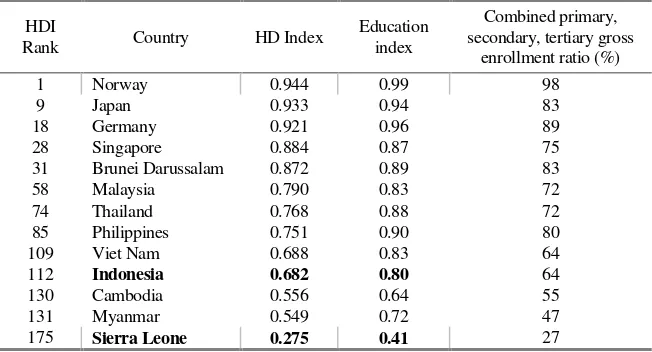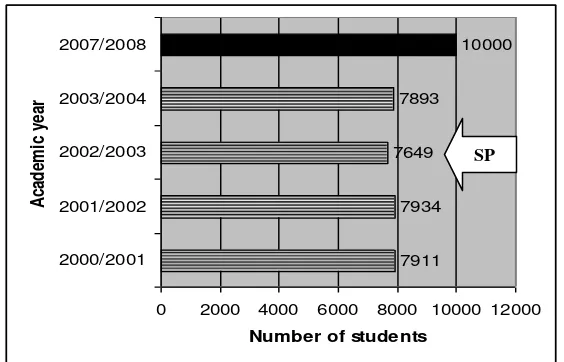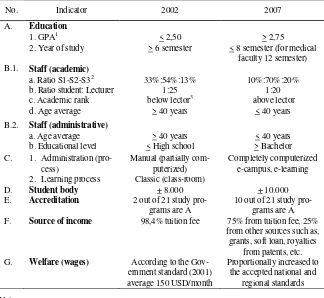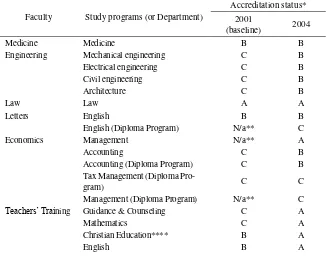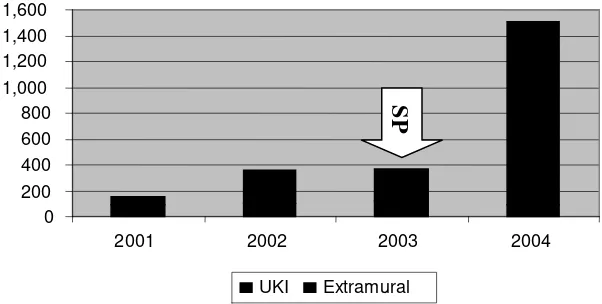in University Context:
An Experience of a Mid-size Private
University in Indonesia
Abraham Simatupang1& Ied Veda R. Sitepu2
Abstract: Due to the rapid change of social, political and economic aspects in the national, regional and global context, universities must emphasize more the quality and the ability to adapt to the change. This paper discusses how UKI was imposed to the change through the process of developing and implementing of strategic planning and the changes that were instigated directly or indirectly. The dialogues among the faculty members apparently give a mutual benefit for all stakeholders to have a shared-vision and shared-mission.
Keywords: higher education, change management, strategic planning, learning organization
According to the Human Development Report (Fukuda-Parr, 2003), Indonesia, the 4th populous country in the world after China, India, and USA, is a devel-oping country and its HDI rank (Human Development Index) is 112, behind Viet Nam (109), Philippines (85), Thailand (74), Malaysia (58), and Singapore (28) [see Table 1]. This report shows that although education is an important factor for nation development capacity in Indonesia, it has not been a priority since the allocation of national budget for education is only 2-5% from the total
Abraham Simatupang adalah staf pengajar FKUKI, menekuni farmakologi klinik, Computer Assisted Learning dan Problem-based learning.
Ied Veda R. Sitepu adalah staf pengajar FS UKI, menggeluti English Literature dan Tracer study.
Growth National Product (GNP) (cf. Malaysia or Singapore -- more than 15%). On the contrary, Indonesia, has 56 state universities and around 3000 private universities, which are varied in terms of services, historical backgrounds, and quality. The enormous quantity of higher learning institutions in a country apparently does not give significant meaning to the development of its human resource.
In his bestseller book entitled Who Moved My Cheese? Johnson (1998) brilliantly put forward one of the tricky yet important issues in any organiza-tion: Change or perish! Unfortunately, the urge to change and to become a learning organization (Senge, 1999; Fremerey, 2003) is mostly practiced by the business sectors, and does not affect education sectors. Higher education institutions have been assuming that they have such privileges that the services they offer seem to be the best in quality and that their customers are always loyal (Simatupang, 2003). However, since the government, industries and other stakeholders are more demanding on the performance of the universities, then, this issue has now become intriguing among the faculty members, uni-versities‟ bureaucrats and even the students.
In the business sectors, market changes, in a broad perspective, are moni-tored, evaluated, analyzed and quickly aligned into their organizations. Higher education institutions, too, require the same approaches in order not only to maintain their existence but also to excel in a global context.
In 1997, the government through Badan Akreditasi Nasional (National Accreditation Board) introduced an accreditation system as a performance in-dicator of a study program. At first, quite a number of private universities were skeptical about it and thought that it was just another “red tape”. However, when the accreditation results were made public, and that a number of study programs in the state universities were graded lower than those of the private ones, they changed. The results show that equal opportunity for all universi-ties to demonstrate their effort to enhance their quality was appreciated. Thus, an essence for quality assurance, which forces universities to make a substan-tial change, is now flourishing among the universities.
Unistaff conference, the writers would like to share and tap information on best practices with and from other colleagues and experts to enhance our knowledge and to enrich our experience in change management.
Table 1 Human Development Index (HDI) of Some Selected Countries (Fukuda-Parr, 2003)
HDI
Rank Country HD Index
Education index
Combined primary, secondary, tertiary gross
enrollment ratio (%)
1 Norway 0.944 0.99 98
9 Japan 0.933 0.94 83
18 Germany 0.921 0.96 89
28 Singapore 0.884 0.87 75
31 Brunei Darussalam 0.872 0.89 83
58 Malaysia 0.790 0.83 72
74 Thailand 0.768 0.88 72
85 Philippines 0.751 0.90 80
109 Viet Nam 0.688 0.83 64
112 Indonesia 0.682 0.80 64
130 Cambodia 0.556 0.64 55
131 Myanmar 0.549 0.72 47
175 Sierra Leone 0.275 0.41 27
Note: Education index: One of three indices on which the human development index is built. It is based on the adult literacy rate and the combined primary, secondary and tertiary gross enrolment ratio.
HD Index: a composite index measuring average achievement in three basic dimensions of human development – a long and healthy life, knowledge and a decent standard of living.
ON THE MOVE
among the participants of some of the critical issues regarding the perfor-mance of the university.
Then a seminar on Strategic Planning was organized, followed by a work-shop, to provide an opportunity for the participants to put their knowledge in-to practice. The seminar and workshop were attended not only by UKI fac-ulty members but also by participants from other universities. Some eminent experts in higher education and organization involved in conducting the semi-nar were from the Directorate General of Higher Education of the Department of National Education, ISOS of the University of Kassel, Germany, and Gajah Mada University, Yogyakarta. During the workshop, participants were also trained in how to develop a strategic planning. Each of the seven UKI faculties (Letters, Education and Teachers‟ Training, Economics, Law, Medicine, Engi-neering, and Social and Political Sciences) was to set up its own strategic planning team, and some members of the faculties‟ teams joined the univer-sity‟s strategic planning team who regularly met to discuss and iron out dis-crepancies between the faculties‟ needs and the university‟s.
From it can be seen that the strategic planning is made up of five blocks of activities as follows: pre-planning, strategic planning, dissemination, imple-mentation, and monitoring and evaluation.
Two groups of important activities in the first block were retreat, seminar and workshop, self-assessment and external evaluation. Every faculty, depart-ment and unit was asked to organize a self-assessdepart-ment with standard measure-ment procedures modified from an accreditation standard used by the Direc-torate General of Higher Education.
In the strategic planning block, there are two groups of activities which were considered important, (re)formulation of vision and mission statement and creating this vision statement as the ultimate goal which should be obtained by comparing the present situations and condition of the organization to the future (gap analysis). In order to fulfill these goals, one has to select and pick the strategic goals that are available and possible to be put into realization, because one should consider a SMART (Specific, Measurable, Attainable, Realistic, Timely) approach in setting up goals.
to present it before the Board of Trustees and the Rector. At the end the uni-versity‟s strategic planning team compiled the faculties‟ and units‟ strategic planning to be the university‟s strategic planning. In the fourth block, which is the implementation block, it is notified that some adjustments should be made in accordance to the budget and it is sometimes not favorable. Monitoring and evaluation are two important points in management. The fifth block shows how these points should be done.
Figure 1 Number of Students from the Academic Year of 2001-2003
LESSONS-LEARNED AND SOME FRUITFUL IMPACTS
One of the most exciting parts of constructing the strategic plan, given the varied backgrounds of the faculty members, seemed to have been how to find an agreement on performance for the university to adopt. This was accom-plished after we analyzed and looked thoroughly into the data obtained from a self-assessment prior to the writing of the strategic plan. Strategic issues were then identified and included in the strategic plan. These were, among others, organization performance, teaching and learning, leadership, university‟s im-age, finance and infra-structure, and capacity building. For each strategic issue, goals and performance indicators (see Table 2), such as Grade Performance Average (GPA), length of study, staff-students ratio, accreditation status of the departments were set up.
7911 7934 7649
7893
10000
0 2000 4000 6000 8000 10000 12000 2000/2001
2001/2002 2002/2003 2003/2004 2007/2008
A
ca
d
em
ic
y
ea
r
Number of students
Some of the interim results of the key performance indicators are shown below. Baseline items were measured before or during the self-assessment phase (2001-2002) and the data shown in this article were taken in June 2004. The first data below are the student body (Fig. 2).
The average number of students between academic years of 2000-2003 is 7846 ± 133 students (mean ± SD). In 2007, we project that the number of
students will be around 10,000. Thus, to reach the goal, there should be an in-crease of student enrolment of about 750 students for three consecutive years. We acknowledge that the best way to advertise products is the “word of mouth”; therefore, we are propelling our services to be excellent, and the exis-tence of the alumni could also be UKI‟s best “advertisement”. There are around 20,000 alumni who were once exposed to UKI‟s education system, and if they are now successful in their job, it is assumed that they would, at least, con-sider this institution to be their choice and advertise it to their families, rela-tives and friends. We have also improved our promotion strategy by helping high school students choose a study program, introducing our university pro-grams, and conducting enrolment tests directly in schools. In cooperation with local governments we also conduct a talent scouting, especially in east Indo-nesian provinces in order to give equal opportunity to IndoIndo-nesian high school students who wish to continue their studies in higher education. The talent scouting is made possible through a full support from the local governments that provide scholarship. In turn, the scholarship holders will return to their respective places to help their governments develop their region. In the spirit of autonomy, the role of UKI is still significant.
It took 1.5 years to finish the strategic plan, while we agreed from the beginning that it was not the document (of the strategic plan) that we were striving for, but the process of sharing and the process of reflecting the ‟shared vision‟ that we primarily endeavored. The most ‟ambitious‟ goal of the strategic plan is that in the next five years UKI will be one of the five best universities in the Jakarta greater area, which at the moment has around 300 private universities and two state universities as UKI‟s competitors!
1. To enhance the quality of learning process, and to enhance the administra-tive and academic services through information and communication tech-nology.
2. To improve the quality and capability of the UKI‟s human resources. 3. To improve the quality of the research activities and services to the
com-munity.
4. To increase mutual cooperation with national and international institutions and churches the ecumenical spirit.
From these vision and mission statements, 10 objectives, which will hopefully be completed in the year of 2007, were derived, among others, 1. curriculum that fits to the market demand,
2. increase of the student enrollment standard,
3. increase of the learning and working facilities to boost up a mutual learning environment,
4. Increase of the academic qualification ratios of lecturers from 33%, 54%, 13% to 10%, 70% and 20% of Bachelor, Master and Doctoral degrees, respectively.
Surprisingly, the preparation for designing the strategic plan seemed to have positive results. The Department of Mechanical Engineering of the Fac-ulty of Engineering received a substantial grant of USD. 62,500 of the Semi-QUE (Quality for Undergraduate Education) jointly funded by Asian Devel-opment Bank and the Indonesian government. Several departments received A and B for their accreditation status (see Table 3.).
Table 2 Key Performance Indicators of UKI’s Strategic Planning < 8 semester (for medical
faculty 12 semester) E. Accreditation 2 out of 21 study
pro-grams are A
10 out of 21 study pro-grams are A F. Source of income 98,4% tuition fee 75% from tuition fee, 25%
from other sources such as, grants, soft loan, royalties
from patents, etc. G. Welfare (wages) According to the
Gov-ernment standard (2001)
1. GPA: Grade Performance Average score is between 0-4, where 4 is the highest.
2. Indonesian academic degree: S1, S2, S3 are equivalent to Bachelor, Master and Doctoral de-gree, respectively.
3. Academic rank: Asisten Ahli equiv. Junior Lecturer, Lektor equiv. Senior Lecturer, Lektor Kepala equiv. Assoc. Prof., and Guru Besar equiv. Professor.
for-eign counterparts. The Architectural Department of the Faculty of Engineering, for example, has signed a long term collaboration with Karlsruhe University, Germany, focusing on academic staff exchange, research and setting up a graduate study program for regional planning. Recently, Research Centre of UKI obtained a grant of 187,500 USD from the Partnership for Clean Govern-ance of United Nations for Development Project (UNDP) for introducing and educating indigenous people in Maluku and Papua regions prior to the 2004 (general) election in Indonesia. The increase of extra mural funding of which Research Centre tapped is shown in Fig. 2.
In summary, Table 4 shows the percentage of the accredited study pro-grams in comparison to the baseline (year 2001). It shows that in 2004, 19 out of 21 study programs are accredited, while 2 of them are being accredited as this paper is being written. With regard to the goals, in 2007, at least more than 50% (> 10) of the study programs shall be accredited with A.
Table 3 Accreditation Status of Undergraduate Study Programs in 2001 and 2004
Faculty Study programs (or Department)
Accreditation status*
2001
(baseline) 2004
Medicine Medicine B B
Engineering Mechanical engineering C B
Electrical engineering C B
Civil engineering C B
Architecture C B
Law Law A A
Letters English B B
English (Diploma Program) N/a** C
Economics Management N/a** A
Accounting C B
Accounting (Diploma Program) C B Tax Management (Diploma
Pro-gram) C C
Management (Diploma Program) N/a** C Teachers‟ Training Guidance & Counseling C A
Mathematics C A
Christian Education**** B A
Faculty Study programs (or Department)
Accreditation status*
2001
(baseline) 2004
Biology N/a** ***
Physics N/a** ***
Social and political sciences
Communication N/a** B
International relations N/a** B
Note: * Accreditation status according to the National Accreditation Board is ranked to a. not accredited, b. C, c. B, and d. A..
** When the self-assessment was done in 2002, some of the study programs have not been examined for its accreditation by the National Accreditation Board. *** In the process of accreditation.
**** Accredited by the Department of Religion Affairs of the Republic of Indonesia. Graduates study for Education Management, at the moment, is being assessed by the National Accreditation Board.
Table 4 Percentage of accredited study programs
Accreditation status of study programs
Percentage of accredited study programs
2001 (baseline) 2004
N/a 33% (7) 0% (0)
C 43% (9) 14% (3)
B 19% (4) 48% (10)
A 5% (1) 29% (6)
Figure 2 Funding of Research Centre (in million rupiah). Open arrows shows where the SP started
The eastern parts of Indonesia are less privileged than the other regions due to the lack of infra structures, skilled workers, and managerial capability of the local leaders. In 2000, two years after the authoritarian regime was top-pled down, the government introduced decentralization decree which gives more freedom and spaces to the local governments for self governing. Due to its motto, UKI has been actively promoting and facilitating local governments to fulfill these new trends of management and governing, by tailoring special development programs for the local needs, for example students‟ recruitment program, master degree program offered to the local civil servants, seminars and workshops on laws, democracy and human rights, HIV-AIDS, etc.
We believe that a “snow ball” effect through the process and installment of strategic planning has just started.
SEEING IS BELIEVING: QUESTIONS TO BE ANSWERED
Quality improvement is a key issue for any higher education institution in the ever-changing education and job market situation, and this is not only true for the developing world but also for the developed world. Some institu-tions respond to this issue immediately but many do not or they just ignore it due to lack of capability to respond to it. The capability to shift the paradigms is one of the effective means to trigger change. This is –somehow– a tricky problem for the university stakeholders to solve. It is indeed not an easy task
0 200 400 600 800 1,000 1,200 1,400 1,600
2001 2002 2003 2004
UKI Extramural
to guarantee that the change process will give positive results rapidly. To maximize the results, people are encouraged to do small (piecemeal) changes first. Resistance, doubts, skepticism, disputes are some factors people will usu-ally encounter through the process. A strong and consistent leadership is indeed a decisive factor to overcome the situation (Clark, 1996). We observed not all departments or units have success stories due to this.
A question of synergizing also appears to be another important factor to consider.
Organizational research, on the hand, should also be conducted to get clear insight for the stakeholders (Mintzberg et al, 1997 and Morrison et al, 1984). Last but not least, introducing change in university needs courage and it is an „art‟ in itself.
ACKNOWLEDGMENT
Authors wish to thank Ika Bali, Mompang Panggabean and Ganda Huta-pea, colleagues from the Faculty of Engineering, Faculty of Law and Faculty of Economics, respectively, who gave their great contributions in preparing the seminar and workshops on strategic planning. Mompang Panggabean and Ganda Hutapea also had jointly designed a self-evaluation questionnaire for monitoring purposes of the strategic planning which is used to add some im-portant facts to this paper.
REFERENCE
Clark, F. 1996. Leadership for Quality: Strategies for Action. London: McGraw-Hill Book Comp.
Fremerey, M. 2003. The University – A Learning Organization? In I. Sitepu (Ed.),
Agar Semua Menjadi Baru: Refleksi 50 Tahun UKI (pp 240-257). Jakarta: UKI Press.
Fukuda-Parr, S. 2003. Human Development Report 2003. Millennium Development Goals: A Compact among Nations to End Human Poverty. New York: Oxford University Press.
Jaffe, D.T. & Scott, C.D. 1999. Getting Your Organization to Change. Menlo Park: Crisp Publ.
Johnson, S. 1998. Who Moved My Cheese? New York: G.P. Putnam‟s Sons.
Lewis, R.G. & Smith, D.G. 1994. Total Quality in Higher Education. Delray Beach, Florida: St. Lucie Press.
Morrison J.L., Renfro, W.L. and Boucher, W.I. 2003. Futures Research and the Strate-gic Planning Process: Implications for Higher Education. ASHE-ERIC. Research Reports 1984, (Online), (http://horizon.unc.edu/projects/seminars/futuresresearch/ contents.asp,accessed June 18, 2003).
Senge, P.M. 1999. Leading Learning Organizations. The Bold, the Powerful, and the Invicible. San Francisco: Jossey-Bass.
Simatupang, A. 2003. Akselerasi Peningkatan Kualitas Perguruan Tinggi (Increasing the Acceleration of the Quality of Higher Education Institutions). In I. Sitepu (Ed.), Agar Semua Menjadi Baru: Refleksi 50 Tahun UKI (pp 25-37). Jakarta: UKI Press.
Simatupang, A., Sitepu, I.V. & Panggabean, M. 2003. Rencana Strategis Universitas Kristen Indonesia (Strategic Planning of UKI). Jakarta: UKI Press.
Sitepu, I.V. & Polla, G. (Eds.). 2001. Kinerja Universitas Kristen Indonesia (Perform-ance of UKI). Jakarta: UKI Press and LP UKI.
